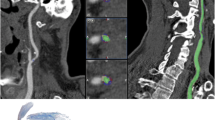Abstract
Atherosclerotic plaque burden has a strong correlation with plaque vulnerability. Three-dimensional (3D) volumetric assessment of atherosclerotic plaques has been suggested as an accurate method of quantifying plaque burden but has not been performed. In this study we use high-resolution magnetic resonance (MR) imaging to compare 3D volume differences of asymptomatic and acutely symptomatic carotid plaques (i.e. had cerebrovascular ischaemic symptoms within the previous 72 h of MR imaging). One hundred patients (46 acutely symptomatic and 54 asymptomatic) with atherosclerotic carotid artery disease underwent carotid MR imaging. Manual segmentation of plaque components was done to delineate lipid, fibrous tissue and plaque haemorrhage (PH). 3D-volume reconstruction of plaque components was done and used for comparison. Acutely symptomatic plaques had a lower normalized wall index and normalized volume index than the asymptomatic group (P = 0.04 and 0.01 respectively). Median percentage lipid volume was higher for asymptomatic plaques (28 vs. 5%, P = 0.004). However, the median percentage volume and prevalence of PH was higher in the acutely symptomatic group (P = 0.01 and 0.02 respectively). Acutely symptomatic plaques have less lipid content immediately after the acute event than asymptomatic plaques. This is most likely because of the escape of lipid-rich atheromatous debris into the blood stream at the time of plaque rupture. Due to this paradox, “high” lipid content of a plaque may not be a reliable feature of estimating its vulnerability immediately following the acute event. PH, which is prevalent and consistent in such plaques, may be a better indicator of plaque vulnerability during that period.



Similar content being viewed by others
References
Falk E (1992) Why do plaques rupture? Circulation 86:III30–III42
Crawford T, Dexter D, Teare RD (1961) Coronary-artery pathology in sudden death from myocardial ischaemia. A comparison by age-groups. Lancet 1:181–185
Sakariassen KS, Barstad RM (1993) Mechanisms of thromboembolism at arterial plaques. Blood Coagul Fibrinolysis 4:615–625
Eliasziw M, Kennedy J, Hill MD, Buchan AM, Barnett HJ (2004) Early risk of stroke after a transient ischemic attack in patients with internal carotid artery disease. CMAJ 170:1105–1109
Mitsumori LM, Hatsukami TS, Ferguson MS, Kerwin WS, Cai J, Yuan C (2003) In vivo accuracy of multisequence MR imaging for identifying unstable fibrous caps in advanced human carotid plaques. J Magn Reson Imaging 17:410–420
Saam T, Cai J, Ma L et al (2006) Comparison of symptomatic and asymptomatic atherosclerotic carotid plaque features with in vivo MR imaging. Radiology 240:464–472
Howarth SP, Tang TY, Trivedi R et al (2009) Utility of USPIO-enhanced MR imaging to identify inflammation and the fibrous cap: a comparison of symptomatic and asymptomatic individuals. Eur J Radiol 70:555–560
U-King-Im JM, Tang TY, Patterson A et al (2008) Characterisation of carotid atheroma in symptomatic and asymptomatic patients using high-resolution MRI. J Neurol Neurosurg Psychiatry 79:905–912
Yuan C, Mitsumori LM, Ferguson MS et al (2001) In vivo accuracy of multispectral magnetic resonance imaging for identifying lipid-rich necrotic cores and intraplaque hemorrhage in advanced human carotid plaques. Circulation 104:2051–2056
Sadat U, Weerakkody RA, Bowden DJ et al (2009) Utility of high resolution MR imaging to assess carotid plaque morphology: A comparison of acute symptomatic, recently symptomatic and asymptomatic patients with carotid artery disease. Atherosclerosis 207(2):434–439
Kubo T, Imanishi T, Takarada S et al (2007) Assessment of culprit lesion morphology in acute myocardial infarction: ability of optical coherence tomography compared with intravascular ultrasound and coronary angioscopy. J Am Coll Cardiol 50:933–939
Virmani R, Kolodgie FD, Burke AP, Farb A, Schwartz SM (2000) Lessons from sudden coronary death: a comprehensive morphological classification scheme for atherosclerotic lesions. Arterioscler Thromb Vasc Biol 20:1262–1275
Cappendijk VC, Kessels AG, Heeneman S et al (2008) Comparison of lipid-rich necrotic core size in symptomatic and asymptomatic carotid atherosclerotic plaque: Initial results. J Magn Reson Imaging 27:1356–1361
U-King-Im JM, Tang TY, Patterson A et al (2008) Characterisation of carotid atheroma in symptomatic and asymptomatic patients using high resolution MRI. J Neurol Neurosurg Psychiatry 79:905–912
Trivedi RA JMUK-I, Graves MJ et al (2004) MRI-derived measurements of fibrous-cap and lipid-core thickness: the potential for identifying vulnerable carotid plaques in vivo. Neuroradiology 46:738–743
Acknowledgments
Dr. Umar Sadat is supported by a Medical Research Council UK & Royal College of Surgeons of England Joint Clinical Research Training Fellowship. This research has also been supported by a Biomedical Research Centre National Institute of Health Research (BRC NIHR) grant.
Author Contributions
US developed the hypothesis, designed the study, performed the study, analysed the bulk of the data and wrote the manuscript; ZT performed the volumetric analysis of the entire data; VEY contributed to the morphological MR data analysis; MJG wrote the MR pulse sequences for this study; JHG confirmed the accuracy of the MR data and supervised the entire project and writing of the manuscript.
Conflict of interest statement
None.
Author information
Authors and Affiliations
Corresponding author
Rights and permissions
About this article
Cite this article
Sadat, U., Teng, Z., Young, V.E. et al. Three-dimensional volumetric analysis of atherosclerotic plaques: a magnetic resonance imaging-based study of patients with moderate stenosis carotid artery disease. Int J Cardiovasc Imaging 26, 897–904 (2010). https://doi.org/10.1007/s10554-010-9648-6
Received:
Accepted:
Published:
Issue Date:
DOI: https://doi.org/10.1007/s10554-010-9648-6




